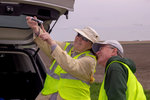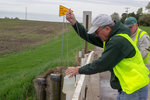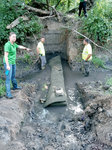



Twenty years of Scott County creek monitoring hasn’t provided all of the answers, but there’s a lot less guessing about water quality.
An army of volunteers dipping into Duck, Mud, Sycamore and other creeks each year analyzed samples for clarity, different forms of nitrogen, chloride from road salt runoff, and dissolved oxygen.
Partners of Scott County Watershed board member Steve Gustafson said years of sampling show no dangerous levels. But data shows consistently climbing nitrogen, phosphorous and turbidity, or clearness, issues.
“We have water quality issues, trends that are not going the right way,” Gustafson said.
The county watershed board is assembling the data, and the network of professionals and residents to find answers the Iowa DNR stopped looking for.
Voluntary testing in the county since 2000 built a timeline of observations useful for identifying lo
had provided more detailed field testing, but dropped that program in 2018, leaving the watershed volunteers as the only ones systemically monitoring county streams.
Gustafson said DNR’s withdrawal makes the local snapshot surveys even more important to identify trends, and build a network of urban and rural volunteers eager to address them.
The network keeps growing, watershed partners coordinator Cassie Druhl said.
“We have our regular group of loyal senior citizens who participate in snapshots. We have former and current farmers, and urban residents with a natural interest,” she said. Add in high school and college environmental clubs.
“City of Eldridge public works people have helped in the past. It’s super easy to learn,” she said.
Snapshots resume in May
The first of three 2021 snapshot days will be 8 a.m. to noon, Tuesday, May 4, followed by Saturday, July 17 and Tuesday, Oct. 5.
Volunteers are given sampling jugs, test strips and other gear, then sent to a few of the 62 collection sites at lakesides, stream banks and bridges.
Site assignments are tailored to volunteers’ interests and abilities.
“You can get wet if you want to,” Gustafson said. But most volunteers do not.
“If you’re bringing a 7-year-old, we’ll keep them by the bike trail sites. Then we have the die-hards who don’t care where they go,” he said.
The day begins with training so everyone is comfortable with the sampling procedures.
This year, some volunteers will have apps so data can be entered at the scene through phones and compiled almost immediately.
Each snapshot draws 20-30 volunteers for the four-hour duty.
The partners got grant funding for 10 more snapshot sampling kits to accommodate even more volunteers.
2021 plans
The watershed partners also hope to install more stream-bed filters, like those added to Davenport’s Robin Creek last August. Borrowing an idea from another Iowa watershed district, the Scott County partners put four filter layers that look a bit like carpet padding strips. Iowa American Water provided the grant for the strips. St. Ambrose University faculty and students will be testing the water to determine its effectiveness at reducing bacteria levels, Druhl said.
The filtering, monitoring and other efforts are aimed at measuring contaminant levels, and building urban and rural collaborations to address them.
Gustafson said accurate data will lead to effective solutions, not blame.
“Let’s work with people to come up with solutions. Regardless of what governments do or don’t do, if people are willing to help, it will get done,” he said.
A mix of rural and urban partnership board members hope to be seen as problem-solvers.
The partners are that neutral third party that can help you see if there’s a problem, what it is, and what help is available,” Gustafson said.
That can include consultation on stream bank stabilization, on site, or through online forums the partners are continuing in 2021.
The online forums are noon to 1 p.m., the third Tuesday of each month.
This year’s forums resume at noon, Tuesday, Feb. 16. Jared McGovern from the National Mississippi River Museum and Aquarium will present.
Find more information at the partnership website partnersofscottcountywatersheds.org, or the group’s Facebook page.
Druhl said the partners also hope to develop kayaking and canoeing sites along Duck Creek. Gustafson said that involves working with kayakers to assess accessibility at different water levels, then establish drop-in sites and identify cleared stretches for recreational passage.
“We can figure out when levels are too high, or too low, and work with kayakers to find safe, easy-to-reach sections,” Gustafson said.
Snapshot conclusions
Nutrients are an urban, suburban and rural concern. “It’s not just coming in from rural to urban.”
Most creeks and streams originate in the county, “so water quality issues are our problems.”
Limited fecal source testing shows cattle or swine is present in rural streams, but far from dangerous levels.
Dissolved oxygen: Rural averages of 8 micrograms per liter remain above 5 mg level to support aquatic wildlife. Urban and suburban sites averaged about 7 mgs. Long-term trends showed no worrisome spikes. Creeks with concerns include Candlelight, Blackhawk and Hanlin.
Nitrates: 2020 sampling showed nitrate levels increasing at 64 percent of rural sampling sites, and 60 percent of urban sites. Levels fell at 13 percent of rural and 10 percent of urban sites; and stayed the same at 23 percent of rural sites and 30 percent of urban sites.